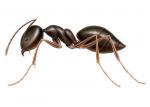Pest Identification
You're visiting our pest identification library with information about the biology and control of common household pests.
Odorous House Ant
| Appearance |
|---|
 Brown; about 1/8 inch long. Brown; about 1/8 inch long. |
| Habitat |
| Outdoors house ants nest in soil, often under objects such as loose bark, firewood or lumber. Indoors they nest in wall voids, especially around hot-water pipes and heaters, and in crevices around sinks and cupboards. This species gets its name from the strong, rotten coconut-like smell it gives off when crushed. Odorous house ants may develop huge colonies containing up to 100,000 ants with many queens, making professional ant control imperative. They are not aggressive towards other colonies, so multiple nests may be located within one structure. |
| Diet |
|
Prefer to feed outdoors on organic materials. When indoors, odorous house ants prefer sweets during most of the warm season, especially melon, but will also eat high-protein foods, greasy meats and cheeses.
|
| Control |
| They key to odorous house ant control is locating the colonies and subcolonies and treating them directly. Colonies can be difficult to locate because they commonly nest in crawl spaces and wall voids. Regular inspections and service are necessary to find and treat new colonies as they move from neighboring properties. Eliminating standing water and removing tree limbs and other debris from your yard should help with odorous house ant control. |






